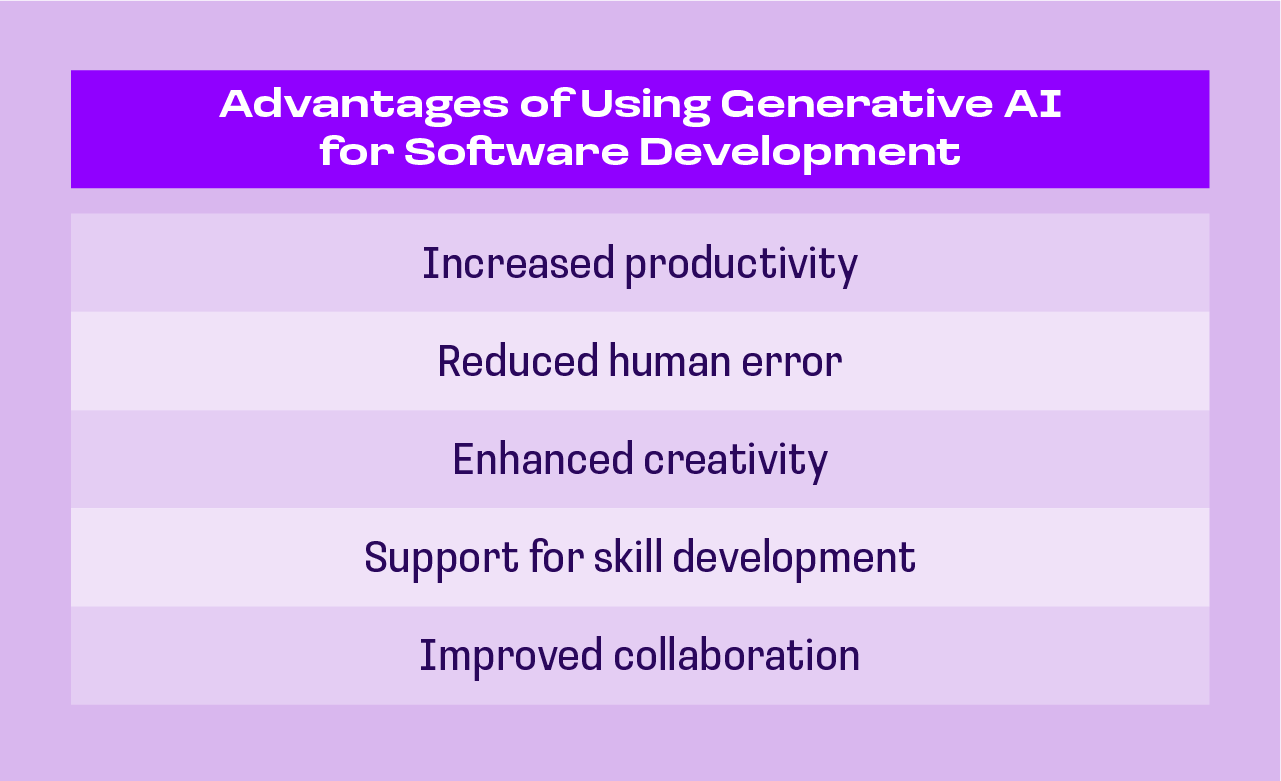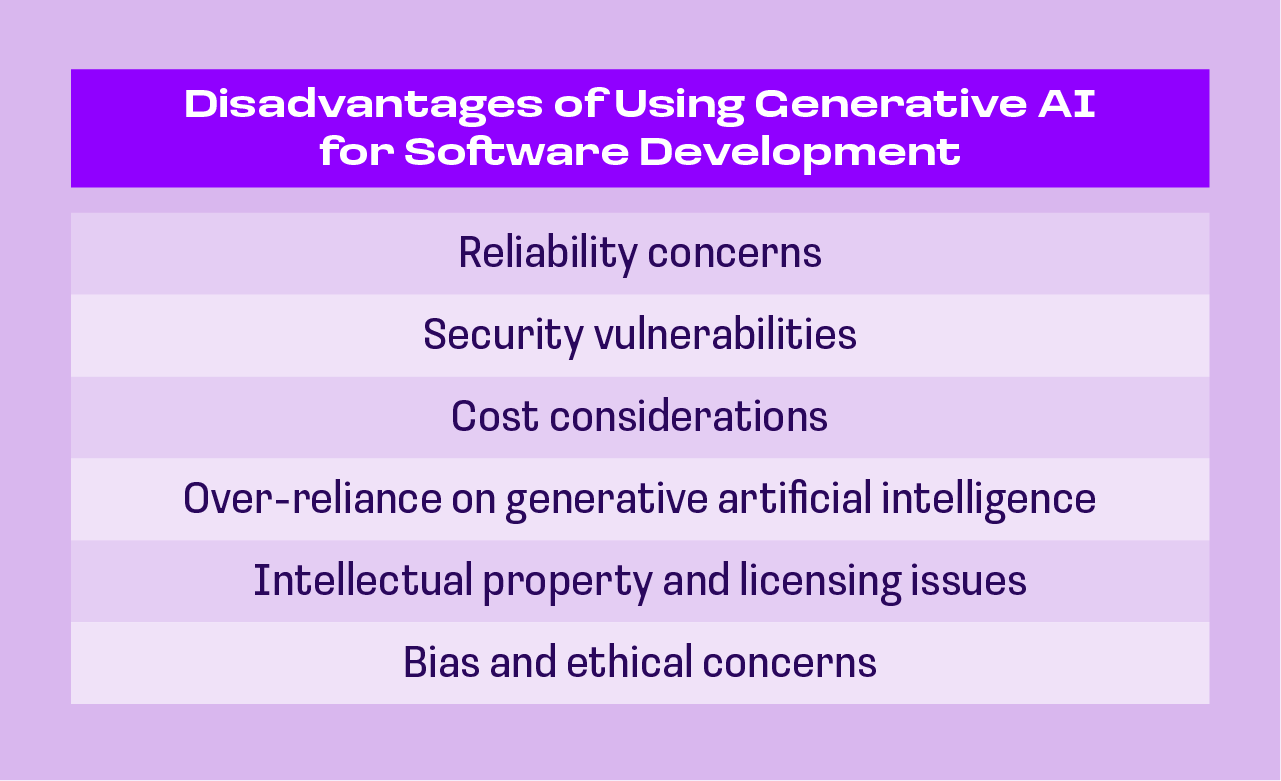Gen AI for Software Development: Benefits and Practice Guide to Use
The author of this article is tech expert Pieter Murphy. Invited expert — Senior Engineering Manager at EPAM, the creator of AI-Supported Software Engineering course Aliaksandr Trafimenka.

Did you know that it took ChatGPT only five days to get one million users, while Netflix took three and a half years to reach the same number of users?
Since 2022, the emergence of generative AI tools that can produce sounds, images, text, and even computer coding has radically transformed the everyday mainstream IT landscape.
The rapid increase of generative Artificial Intelligence in software development has made AI for developer productivity a significant component of many organizations and companies, coupled with DevOps or cloud computing to boost potential.
The numbers are quite impressive. Based on the information from Zion Market Research in 2023, the global generative AI market was valued at $13.24 billion and is expected to grow to $112.27 billion by 2032.
However, there is a noteworthy difference between AI and generative AI. While traditional AI relies on predetermined rules when tackling certain problems, generative Artificial Intelligence focuses on creating new data and content in context after training on vast datasets.
Traditional AI also uses discriminative models and supervised learning, whereas generative AI uses generative models and unsupervised learning.
What Value Does Generative AI Bring to the Work of a Software Developer
Generative AI tools are already influencing how software developers write and build software.
While the technology’s applications in software development are still being defined, today, there are already established methods for how to boost your productivity with AI tools.
Assistance with complex code translation tasks
According to a study presented at the 2021 International Conference on Intelligent User Interfaces, generative AI gives developers a skeletal framework with which to translate legacy source code into Python.
The suggestions that generative Artificial Intelligence gave were not always accurate, but in such instances, it was much easier for developers to assess and fix the errors rather than manually translating the source code from scratch.
The developers involved in the study also noted that the process of making corrections was similar to code review, which they already do when reviewing code from their colleagues.
More efficient coding
While modern Integrated Development Environments (IDEs) have had autocompletion for years now, Large Language Models (LLMs) can come up with longer suggestions or multiple lines of code that often are more relevant.
A study that was published in 2022 in the Proceedings of the Association for Computing Machinery on Programming Languages (PACMPL) observed 20 developers who interacted with GitHub Copilot. It reported that programmers can stay in the flow longer and code faster due to the end-of-line suggestions for argument completions and function calls.
Problem-solving
Generative AI in software development enables engineers to find solutions without leaving their IDEs. Generative models can generate unexpected and novel solutions that may have been inconceivable through traditional development approaches.
For example, when designing user experience (UX) prototypes, generative Artificial Intelligence can provide a wide range of design alternatives based on input specifications or the challenge. These generated designs can fix the problem or inspire developers to explore new design possibilities altogether.
Similarly, by generating code snippets based on examples or hindrances, generative models enable developers to explore new coding styles, optimizations, and algorithms, resulting in more compelling and differentiated software solutions.
Developers also use generative AI to understand code they didn’t write but need to maintain or upgrade. It also makes their work easier by providing guidance on which libraries or classes of code have the needed functionality.
Software developers also rely on technology to simplify code and jump-start new tasks by writing code that goes beyond templates or stub code.
Advantages and Disadvantages of Using Generative AI for Software Development
Like any powerful tool, generative AI comes with both advantages and disadvantages. Let’s now discuss some of the benefits and potential pitfalls of using this technology in software development.
Advantages of Using Generative AI for Software Development
Increased Productivity
One of the most significant benefits of using AI in software development is the dramatic increase in productivity. Recent generative AI models like OpenAI’s GPT-4 can generate documentation, write code snippets, and even debug errors.
This allows developers to focus on more creative and complex aspects of their projects, resulting in faster development cycles and quicker time-to-market for new applications.
Reduced Human Error
Human error is an inevitable part of programming which often leads to bugs and vulnerabilities. Using generative AI for software development can help minimize such errors by automating repetitive tasks and providing accurate suggestions.
This leads to software that is more secure and robust because generative Artificial Intelligence tools can consistently adhere to coding standards and best practices.
Enhanced Creativity
Generative AI can provide additional help in brainstorming sessions and generation of new ideas. For example, it can offer innovative approaches or suggest multiple ways of solving a problem that may not be obvious to the developer.
Using generative Artificial Intelligence in education can lead to unique and more creative software solutions, challenging the boundaries of what is possible in software development.
Support for Skill Development
When optimally applied, learning with AI-assisted tools can be beneficial for both new and experienced software developers. It can help them improve their coding skills and understand complex concepts through instant feedback and providing instant feedback.
Generative AI in education makes access to upskilling and improvement more accesible and inclusive.
Improved Collaboration
Incorporating generative AI software development fosters better collaboration among team members by providing a common platform for code generation and review. This streamlines communication and ensures everyone involved in the project is on the same page, reducing misunderstandings and enhancing overall team productivity.

Disadvantages of Using Generative AI for Software Development
Reliability Concerns
Despite its impressive potential, generative Artifificial Intelligence isn’t without faults or risks. The quality of the code it generates can vary depending on a number of factors. There are where AI produces suboptimal or incorrect solutions.
It is unwise to rely too heavily on AI-generated code. To avoid issues in the final product and make it more reliable, consider pairing generative AI’s work with proper review and testing.
Security Vulnerabilities
Like any other tools, generative ArtificiaI Intelligence can introduce security vulnerabilities if not used carefully. AI-generated code may not always adhere to the latest security standards or best practices and this could potentially expose applications to cyber threats. Developers ought to remain vigilant and thoroughly audit AI-generated code.
Cost Considerations
It can be costly to implement generative AI tools in terms of both computational resources and financial investment.
Independent developers and small companies have limited access to these tools because they may find it hard to to afford AI-supported tools.
Additionally, the training and maintenance of generative Artificial Intelligence models require skilled personnel and significant computational power, which can be a barrier for some organizations.
Over-Reliance on Generative Artificial Intelligence
It is a growing concern in the software development sphere that developers may become overly dependent on generative AI for software engineering, which could lead to a decline in their own problem-solving and coding skills.
Generative Artificial Intelligence is a powerful and helpful assistant, but it should not replace the expertise and critical thinking of human developers.
Intellectual Property and Licensing Issues
Using generative AI in software development raises certain concerns about intellectual property and licensing. It might not be clear who owns the rights to AI-generated code and this could lead to potential legal disputes.
It is up to companies and developers to navigate such complex legal issues to ensure compliance and protect their intellectual property.
Bias and Ethical Concerns
Generative AI models are trained on vast datasets, which sometimes include inappropriate or biased content. This can result in the generation of biased code or solutions that reflect the prejudices found in the training data.
Software developers have the responsibility of addressing such ethical concerns and taking steps to mitigate bias in AI-generated outputs. It's essential to consistently tackle machine learning ethical issues for fair and transparent AI applications.

How to Use Generative Artificial Intelligence for Software Development
Generative AI is sparking new ideas and bringing fresh solutions to long-standing problems in software development. Here’s how you can use GenAI for software developers.
Code Generation
Writing code is often prone to error and time-consuming, but generative AI can help by generating code based on examples or written instructions.
For instance, OpenAI’s Codex is an effective code-generation tool that uses large-scale language models to come up with a code in multiple programming languages.
Codex understands natural language prompts and can, therefore, generate code snippets for various tasks that range from simple utility functions to complex algorithms. You can use code generation tools like Codex to make programming faster and easier.
Design and UI/UX Prototyping
Design and user interface/ user experience (UI/UX) prototyping benefit from the capabilities of visual generative AI. Designing visually appealing and intuitive user interfaces is an important part of software development, but getting the desired results usually involves extensive manual effort and iteration.
Developers use generative Artificial Intelligence models to automatically generate design mockups, prototypes, and mockups based on user feedback and other design specifications.
Tools like Adobe Sensei and Runway ML use generative Artificial Intelligence techniques to help designers create appealing and user-friendly interfaces.
You can leverage generative AI tools to explore a wider range of design alternatives, iterate faster, and ultimately deliver better user experiences.
Text Generation and Content Creation
Most users leverage generative AI for content creation and for programmers, it includes deploying it for tasks in software development. These tasks include crafting personalized user recommendations, writing marketing copy, and generating documentation.
Generative models help developers to generate high-quality textual content that resonates with stakeholders.
For example, OpenAI’s GPT-3 is a language model that uses input prompts to generate human-like text. Developers too can use GPT-3 to generate natural language responses to queries from users, automate repetitive writing tasks, and create interactive chatbots capable of engaging users in meaningful conversations.
Save time and resources by using generative Artificial Intelligence to come up with content. It will also help you ensure quality and consistency in your communications and give users a more personalized experience.
Testing and Debugging
Unlike traditional testing methods that are error-prone and can be time-consuming because they rely on manual test case creation and execution, generative AI can identify edge cases, automate test case generation, and even predict potential sources of vulnerabilities and errors.
Tools like DeepTest and Diffblue make use of generative Artificial Intelligence techniques to automatically generate test inputs to trigger specific code paths, identify potential bugs, and even suggest possible fixes for common coding errors.
You can learn more about how to use generative Artificial Intelligence in software development in EngX’s AI-Supported Software Engineering course. Expert Aliaksandr Trafimenka, a Senior Engineering Manager at EngX, says the following about the methods of generative AI that will be described in the course:
In our EngX AI-Supported Software Engineering course, we’re going to explore some really powerful techniques that will boost your software engineering skills.
First, a quick overview of what Large Language Models, or LLMs, are so you can understand where all these modern approaches come from. Think of them as the brain power behind AI’s ability to understand and generate human-like text.
Next, we’ll look at the first method using conversational tools. Conversational tools are AI-powered interfaces, like chatbots, that can help you solve problems interactively. Whether you need quick answers, code snippets, or just guidance on a complex question, these tools are your go-to. We’ll show you how to integrate LLMs into these conversational interfaces to make your interactions smooth and productive.
The fun part: the art of Prompting. Crafting the prompt is like casting a spell. The better your prompt, the better the AI’s response. We’ll teach you techniques for creating effective prompts that give you exactly what you need from AI, whether it’s generating code, writing documentation, or even brainstorming new features.
Next, we’ll walk you through the practical use of ChatGPT in software development, and you’ll learn how to customize it to your specific project needs and see how it transforms your workflow. We will take a look at specific techniques for task research or how to create new methods and classes from scratch, or even the whole module. Will see how we can improve our efficiency for refactoring code or finding a bug using ChatGPT or similar tools. An important point is that we will learn how to write unit tests much faster and better and generate test data for them.
What Skills Should an Engineer Have to Use Generative AI for Software Development Successfully
To successfully use generative AI, software developers need a combination of technical and soft skills. Here’s a breakdown:
Technical Skills
- Programming: Software engineers should be proficient in programming languages like Python, JavaScript, or any others that are relevant to the project.
- Machine Learning and AI: An understanding of machine learning concepts, including deep learning, neural networks, and supervised and unsupervised learning. An engineer should also be familiar with frameworks like TensorFlow, PyTorch, or Keras, and have knowledge of pioneers in the field such as Christopher Strachey's work on AI development.
- Data science: Engineers need skills in data collection, cleaning, and processing as well as the ability to analyze and visualize data using tools like Pandas, NumPy, and Matplotlib.
- Natural Language Processing (NLP): To use AI successfully as a software developer, you’ll need an understanding of NLP techniques and libraries like NLTK, spaCy, and Transformers together with knowledge of language models such as GPT-3 and BERT.
- Software development: Using generative AI requires proficiency in software development methodologies like Scrum and Agile and practices such as version control like Git, continuous integration/continuous deployment (CI/CD), and debugging.
- Cloud computing: You’ll need experience with cloud platforms like Google Cloud, AWS, and Azure for deploying AI models and managing infrastructure.
- Application Programming Interface (APIs) and integration: To work with software engineers requires a working knowledge of RESTful APIs and experience in integrating AI models into existing software systems.
It is also an added advantage to have analytical skills like Mathematics and Statistics. A strong foundation in linear algebra, calculus, and probability will help you break down problems and develop effective solutions using AI.
Soft Skills
- Creativity: Solving software development challenges using generative AI could sometimes require innovative thinking.
- Communication: Good communication skills are needed to collaborate with colleagues and explain complex concepts to non-technical stakeholders.
Consider getting some hands-on experience in working with generative Artificial Intelligence models and curate a portfolio that showcases any of the projects or contributions you’ve made to open-source projects.
Best Examples of Effective Use of Generative AI for Software Development
To better understand the transformative nature of using GenAI in software development, it is worth looking through some sample scenarios you can use the technology for:
Scenario 1: Rapid Prototyping
Use Case: A startup wants to quickly develop a prototype of their app to secure funding. GenAI can be used to generate entire app modules, boilerplate code, UI components, and more from high-level descriptions, speeding up the process.
Scenario 2: Legacy Code Modernization
Use Case: An organization needs to modernize a legacy system written in an outdated language. GenAI can help translate the old codebase to a modern language while preserving the logic and functionality and updating the frameworks and syntax.
Scenario 3: Multilingual Development
Use Case: A team is developing a service to support multiple languages. GenAI is perfectly capable of providing code snippets and solutions in different languages, allowing developers to work more efficiently across language barriers.
Scenario 4: Real-Time Code Review
Use Case: A developer needs to write code that adheres to strict quality standards but want to save time on review. GenAI can step in to review it in real-time, suggesting improvements, and highlighting potential issues before they become larger problems.
The scenarios continue and include just about anything that requires an editor/writer function. Other tasks you can use it for include:
- Automated testing
- Personalized assistance
- Bug fixing
- Design-to-code conversion
If you sign up for the EngX AI-Supported Software Engineering Course, you might be asking yourself. “Will the methods of using generative AI be applied to real projects of students?”
Trafimenka responds, “Absolutely, and this is one of the most exciting parts of the course! We don’t just teach you the theory behind these techniques — we make sure you get hands-on experience applying them to real-world projects. Throughout the course, you will solve practical problems that reflect real situations.
For example, in the Coding module, you’ll work on creating new features, writing methods, classes, and modules — all using the LLM’s capabilities to help you. There are mandatory graded assignments to ensure you get hands-on experience.
The skills and techniques you’ll learn in this course are designed to integrate seamlessly into your current and future projects. Whether you’re working on feature development, bug fixing, or technical documentation, the generative Artificial Intelligence techniques we teach will help you streamline these processes and increase your productivity.
By applying these techniques to real-world projects, students not only solidify their knowledge, they also see the tangible benefits of generative AI in their work. This helps them develop a robust skill set that is highly relevant in today’s tech industry. Additionally, assessed practical assignments provide a great opportunity to receive feedback and improve their approach, ensuring that they are prepared to tackle real-world problems with confidence.”
How the EngX AI-Supported Software Engineering Course Will Help You to Use Generative AI for Software Development Productivity
The EngX AI-Supported SoftwareEngineering Course has been designed to help you enhance your software development productivity using generative Artificial Intelligence. You’ll enhance your knowledge and receive practical training on Large Language Models (LLMs) and how to leverage generative AI in prompt engineering, development tasks, project documentation, and development testing.


.png)
